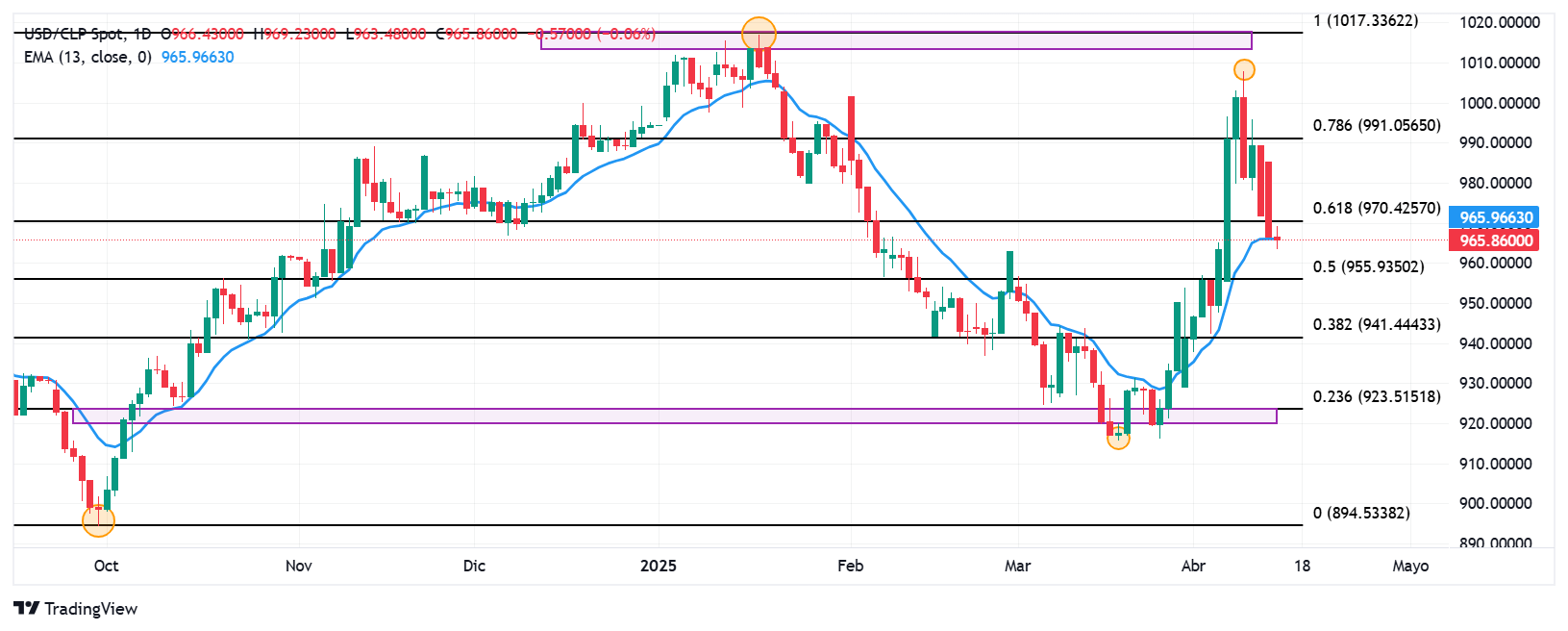- The US dollar operates without significant changes against Chilean peso, contributing currently at 965.70.
- The dollar index (DXY) earns 0.18% in the day, being within Monday’s operational range at 99.90.
- The price of copper goes back 1.67% daily, currently quoting about $ 4,5595 per pound.
- The Empire State manufacturing index improves the projections of analysts when located at -8.1 points in April, although it remains in contraction territory.
- The look of investors will be set on the speech of Jerome Powell, president of the Federal Reserve, tomorrow.
The USD/CLP established a minimum of the day in 963.48, finding buyers who brought parity to a daily maximum in 969.23. At the time of writing, the USD/CLP operates over 965.70, losing 0.08% on Tuesday.
Chilean weight remains stable prior to Jerome Powell’s speech
Based on information presented by the New York Federal Reserve, the Empire State manufacturing index was located at -8.1 points, improving the -20 observed in March and -14.5 projected by analysts. This figure remains in negative territory indicating that commercial activity continued to contain in April.
After this result, the dollar index rises 0.18% today, operating within the Monday session range at 99.90, ending with three consecutive days down.
On the other hand, copper prices fall 1.37% in the day, negotiating at this time in $ 4,5595 per pound, ending two consecutive days with profits.
In this scenario, the Chilean weight slightly extends its profits, reaching maximums of more than a week, while the USD/CLP loses 0.08% on Tuesday, currently quoting at 965.70.
The focus of investors will be in the speech that Jerome Powell, president of the Federal Reserve tomorrow.
Technical levels in the USD/CLP
The USD/CLP established a short -term resistance given by the maximum of April 9 in 1,007.73. The next key resistance is at 1,017.05, maximum of January 17. To the south, the important support zone in 915.57, pivot point of March 19.
USD/CLP daily graphics

US dollar FAQS
The US dollar (USD) is the official currency of the United States of America, and the “de facto” currency of a significant number of other countries where it is in circulation along with local tickets. According to data from 2022, it is the most negotiated currency in the world, with more than 88% of all global currency change operations, which is equivalent to an average of 6.6 billion dollars in daily transactions. After World War II, the USD took over the pound sterling as a world reserve currency.
The most important individual factor that influences the value of the US dollar is monetary policy, which is determined by the Federal Reserve (FED). The Fed has two mandates: to achieve price stability (control inflation) and promote full employment. Its main tool to achieve these two objectives is to adjust interest rates. When prices rise too quickly and inflation exceeds the 2% objective set by the Fed, it rises the types, which favors the price of the dollar. When inflation falls below 2% or the unemployment rate is too high, the Fed can lower interest rates, which weighs on the dollar.
In extreme situations, the Federal Reserve can also print more dollars and promulgate quantitative flexibility (QE). The QE is the process by which the Fed substantially increases the flow of credit in a stuck financial system. It is an unconventional policy measure that is used when the credit has been exhausted because banks do not lend each other (for fear of the default of the counterparts). It is the last resort when it is unlikely that a simple decrease in interest rates will achieve the necessary result. It was the weapon chosen by the Fed to combat the contraction of the credit that occurred during the great financial crisis of 2008. It is that the Fed prints more dollars and uses them to buy bonds of the US government, mainly of financial institutions. Which usually leads to a weakening of the US dollar.
The quantitative hardening (QT) is the reverse process for which the Federal Reserve stops buying bonds from financial institutions and does not reinvote the capital of the wallet values that overcome in new purchases. It is usually positive for the US dollar.
Source: Fx Street
I am Joshua Winder, a senior-level journalist and editor at World Stock Market. I specialize in covering news related to the stock market and economic trends. With more than 8 years of experience in this field, I have become an expert in financial reporting.







